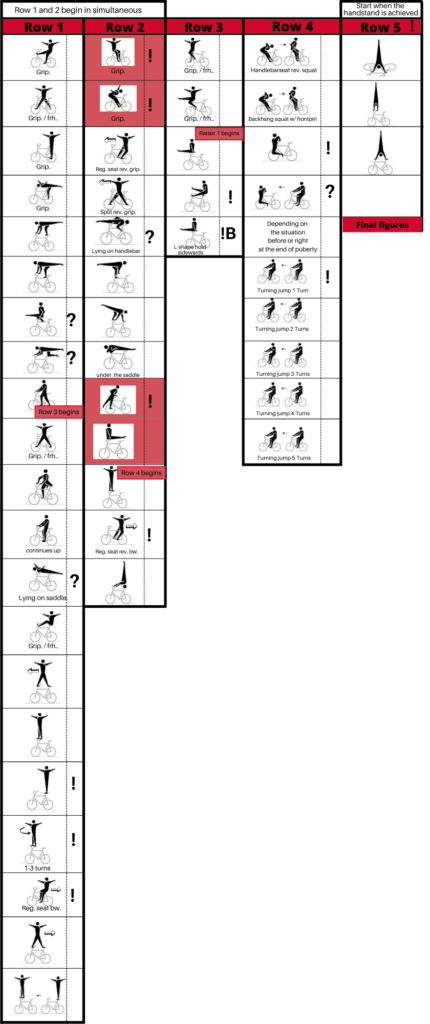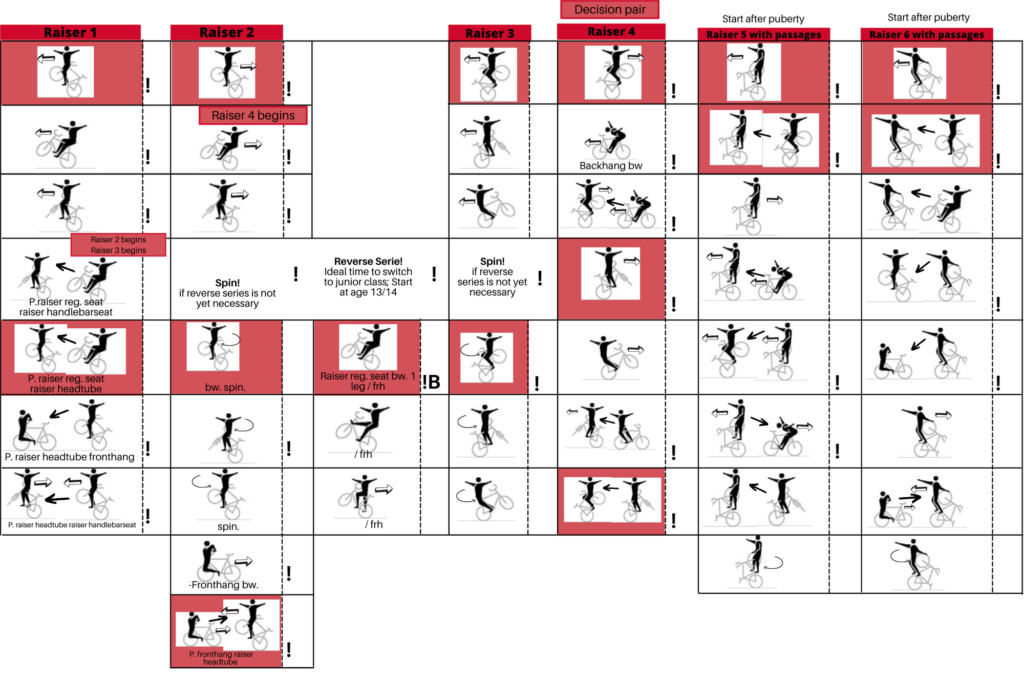This methodical guideline (provided by Dieter Maute) is offering an overview about the artistic cycling figures. It is a recommendation with which figures you can start the training and it shows which figures are based on another. These guidelines enable you to build up your training lessons and help to create the performance and to raise the difficulty of the figures step by step.
Figures with both wheels on the floor

References
Figures with a colored background are basic figures that create prerequisites for a whole series of figures or have a transfer effect. They are therefore particularly important.
If a figure is marked as “Grip”, freehand learning requires considerable learning effort. A transfer effect to other exercises does not exist, therefore it should be avoided.
Figures marked with a question mark can be omitted depending on the student’s learning progress and ability.
No other correct picture available.
Saddlestand: Before learning the saddlestand, the Handlebarstand rev. (in row 2) should be learned. The Handlebarstand rev. is easier and is needed for the handlebarstand turns.
Reg. seat bw.: The Reg. seat bw. is a necessary prerequisite for the saddle handlebarstand bw.. The Reg. seat bw. can also be started earlier if a balancing exercise is needed for training the raiser figures.
Handlebarstand turns: It is important to learn the correct technique in order to enable the enlargement to the handlebarstand 3 turns.
Handlebarseat rev.: At the beginning, the handlebarseat rev. often must be trained accordingly to the body size, so training seated on the top frame tube is possible.
Backhang: Since it is learned in this figure how to steer in reverse position, it can be trained at the same time as the handlebarseat rev. if the pedals can be reached due to appropriate body size. The backhang can be trained earlier without assistance.
Backstand / Handlebar L-shape hold rev.: Both exercises provide a transfer of learning for the squats in row 4 and the handlebar handstand. They should therefore be learned before the squats in row 4.
Reg. seat rev. bw.: Necessary in order to learn the Raiser reg. seat rev, therefore more important than Reg. seat bw.. Corresponding to the stance in the raiser figures, start before the Raiser reg. seat rev and before the Reg. seat bw.
Headstand / Frame shoulderstand: The frame shoulderstand is not essential necessary. Compared with the headstand, the shoulderstand can be performed in a shorter period of time. The headstand requires less skills and therefore better to be learned first. The saddle shoulder stand does not offer any advantages in terms of time like the frame shoulder stand. Start preliminary exercises for the headstand on the floor in advance.
L-shape hold sidewards: Provides transfer to Saddle handlebar handstand. (No other picture available)
Front hang: Needed as a connection in the program when perfoming the Passage raiser reg. seat raiser headtube. Can also be taken into the program if there are time problems.
Turning jump: Technically the most difficult figures. Therefore, train before puberty if possible. Otherwise direct after puberty.
Row 5: The physical requirements for the handstand must be trained from the beginning. This includes the handstand training exercises (including stretching, strengthening trunk, shoulder forward, handstand, …) which should be trained in separate training sessions and integrated into the warm-up.
Final exercises: Depending on the learning progress, final exercises can be selected if they bring time advantages, or the difficulty value is worthwhile. It does not make sense to spend a lot of time learning them. The Handlebarstand rev. stretchjump is suitable as a preliminary exercise for the Handlebarstand rev. somersault bw. hooked legs. The Handlebarstand rev. somersault bw. hooked legs are only useful at the top of the range. It must be prepared in time on the trampoline/floor.
Raiser figures

References
Figures with a colored background are basic figures that create prerequisites for a whole series of figures or have a transfer effect. They are therefore particularly important.
Raiser head tube: Ride the unicycle for a good time, as a basis for learning the raiser head tube.
Raiser reg. seat / Raiser handlebar seat: The raiser reg. seat is more difficult than the raiser handlebar seat, but it is started first because of the risk of falling from the raiser handlebar seat and the associated greater fear. Relatively quickly, the raiser reg. seat and the raiser handlebar seat can then be practiced at the same time.
Raiser reg. seat bw. / Raiser handlebar seat bw.: It is preferable to learn first the raiser reg. seat bw. as this figure is the basis for the entire backward series. The raiser handlebar seat bw. is only followed only by the raiser handlebar seat spin bw. Raiser 3 and 4 series are also preferable to the raiser handlebar seat bw.
Passage raiser headtube fronthang: Required as a connection in the program. Can also be taken into the program if the rider faces problems to keep the time limit.
Passage raiser headtube raiser handlebarseat: Is required as a connection for the raiser handlebar seat spin bw. During this transition, there is also a change from riding forward to riding backwards.
Raiser headtube bw.: The raiser headtube bw. must be technically perfectly mastered. It provides a transfer for the next raiser figures in this row and also for the raiser headtube rev. bw.. Its perfect mastery is a prerequisite for the raiser headtube spin. bw..
Spins: If possible, spins should started before puberty, because of the development of the vestibular apparatus and the large number of exercises needed with spins. The prerequisite for this is the technically perfect riding in the corresponding raiser figures. In this way, the start would be either with the raiser headtube spin. bw. or the raiser headtube spin.. Depending on which raiser figure is technically clean and safe to ride. If it is not yet possible to train the spins by the age of 13/14, it is preferable to train the backwards series.
Raiser handlebarseat spin. bw.: Only after learning the spins from the Raiser 3 series.
Raiser headtube spin.: This is the easiest spin in this series and is therefore trained as the first spin in this series when the raiser headtube is technically perfect and safe.
Backwards series: The ideal time to learn the backwards series is when starting to the Juniors age-group. Here the number of figures in the program is increased from 25 to 30 figures.
Fronthang bw.: Prerequisite for the passage fronthang raiser headtube. Fronthang bw. must therefore be learned in good time.
Passage fronthang raiser headtube: Correct technique (transfer) is a prerequisite for the passage fronthang standraiser rev.. The passage fronthang raiser headtube must be approached in such a way that the correct technique is correctly learned and steady before the passage fronthang standraiser rev. is learned. The learning process for the rows of figures Raiser 2, Raiser 3 and Raiser 4 series shall be prioritized.
Raiser headtube rev. bw.: Ridden in the same direction and hip bend as the raiser headtube bw.. The raiser headtube rev. bw. should start when the raiser headtube bw. is achieved.
Backhang bw.: Is a prerequisite for the passage backhang raiser headtube rev.. Backhang bw. must therefore be learned in good time.
Passage backhang raiser headtube rev.: Correct technique is a prerequisite (transfer) for the passage backhang standraiser.
Raiser handlebarseat rev.: Ridden in the same direction and same hip bend as the raiser reg. seat rev. and can be trained at the same time.
Passage reg. seat rev. raiser handlebarseat rev.: Is required for the raiser handlebarseat rev.
Passage raiser handlebarseat rev. raiser headtube rev: Correct technique is a prerequisite for the passage raiser handlebarseat rev. standraiser: Is required for the passage raiser handlebarseat rev. raiser headtube rev and for raiser handlebarseat rev. backwards and forward
Standraiser / standraiser rev. (Raiser 5 and Raiser 6 with passages): The correct basic posture is only possible when the corresponding strength requirements have been trained and are present. Therefore, these exercises should only be trained after puberty.
Passage raiser headtube rev. standraiser: Correct technique is a prerequisite (transfer) for the P. backhang standraiser and P. raiser handlebarseat rev. standraiser.
Passage standraiser raiser headtube rev. and Passage backhang standraiser: Are required as a connection in the program. Can also be taken into the program in case of timing problems.
Passage raiser headtube standraiser rev.: Correct technique is a prerequisite (transfer) for the P. raiser reg. seat standraiser rev. and P. fronthang standraiser rev.
Passage standraiser rev. raiser headtube and Passage standraiser rev. fronthang: Are required as a connection in the program. Can also be taken into the program in case of timing problems.
